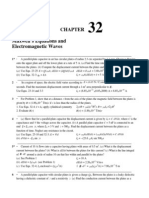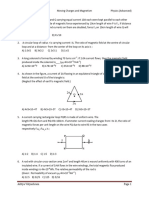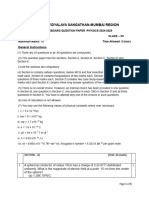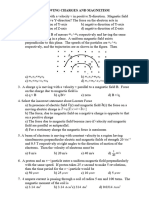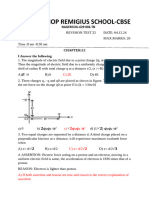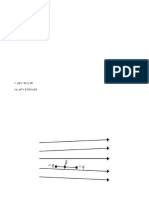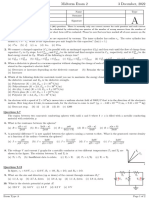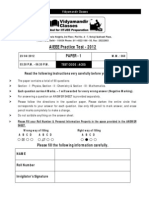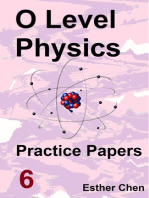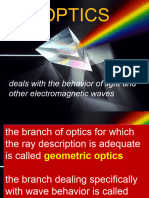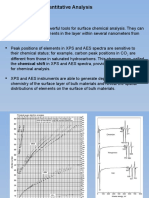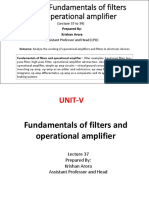2021-2022Y Fiz102E F
2021-2022Y Fiz102E F
Uploaded by
esinyvsCopyright:
Available Formats
2021-2022Y Fiz102E F
2021-2022Y Fiz102E F
Uploaded by
esinyvsOriginal Description:
Original Title
Copyright
Available Formats
Share this document
Did you find this document useful?
Is this content inappropriate?
Copyright:
Available Formats
2021-2022Y Fiz102E F
2021-2022Y Fiz102E F
Uploaded by
esinyvsCopyright:
Available Formats
FIZ 102E Final Exam 17 August 2022
Group Number Name Type
List Number Surname
Student ID
Signature
A
ATTENTION: The exam consists of 20 questions. There is only one correct answer for each question and each correct answer is equal to
1 point. Only the answers on your answer sheet form will be marked. Please be sure that you have marked all of your answers on the
answer sheet form by using a pencil. (Do not use a pen!)
1. A charge is accelerated from rest through a potential difference V and then enters a uniform magnetic field oriented
perpendicular to its path. The field deflects the particle into a circular arc of radius R. If the accelerating potential is
tripled to 3V , what
√ will be the radius of the circular
√ arc?
(a) 9R (b) R/ 3 (c) R (d) R/9 (e) 3R
2. A charged particle is moving with speed v perpendicular to a uniform magnetic field. A second identical charged particle
is moving with speed 2v perpendicular to the same magnetic field. If the frequency of revolution of the first particle is f ,
what is the frequency of revolution of the second particle?
(a) 4f (b) f /2 (c) f (d) 2f (e) f /4
3. An electron moving with a velocity ⃗v = 5 × 107 m/s ı̂ enters a region of space where electric and magnetic fields are
⃗ = 10 kV/m ȷ̂. What magnetic field will allow the electron to go
perpendicular to each other. The electric field is E
through the region without being deflected?
⃗ = 2 × 10−4 T k̂ (b) B
(a) B ⃗ = −2 × 10−4 T ȷ̂ (c) B ⃗ = ⃗0 (d) B ⃗ = 2 × 10−4 T ȷ̂ (e) B⃗ = −2 × 10−4 T k̂
4. A rigid circular loop has a radius of 0.200 m and is in the xy-plane. A clockwise current I = 6.25 A is carried by the loop,
as shown in the figure. A uniform external magnetic field of magnitude B = 0.200 T in the positive x-direction, is present.
Find the magnitude and direction of the magnetic torque exerted on the loop. (Take π = 3.00 for this question.)
(a) 0.250 Nm, d moves out of the plane and b moves into the plane
(b) 0.150 Nm, c moves out of the plane and a moves into the plane
(c) 0.250 Nm, b moves out of the plane and d moves into the plane
(d) ⃗0
(e) 0.150 Nm, a moves out of the plane and c moves into the plane
Figure 1: Q4
5. Two very long parallel wires in the xy-plane, a distance 2a apart, are parallel to the y-axis
and carry equal currents I as shown in the figure. The +z direction points perpendicular to
the xy-plane in a right-handed coordinate system. If both currents flow in the +y direction,
which one of the graphs shown in the figure below best represents the z-component of the
Figure 2: Q5 net magnetic field, in the xy-plane, as a function of x?
(a) (b) (c) (d) (e)
6. As shown in the figure, a wire is bent into the shape of a tightly closed omega (Ω), with a
circular loop of radius 4.0 cm and two long straight sections. The loop is in the xy-plane,
with the center at the origin. The straight sections are parallel to the x-axis. The wire
carries a 5.0 A current, as shown. What is the magnitude of the magnetic field at the center
of the loop? Take π = 3 and µ0 = 4π × 10−7 H/m.
(a) 25 µT (b) 50 µT (c) 40 µT (d) 10 µT (e) 100 µT Figure 3: Q6
7. A long, straight wire with 3 A current flowing through it produces magnetic field strength 1 T at its surface. If the wire
has a radius R, where within the wire is the field strength equal to 36% of the field strength at the surface of the wire?
Assume that the current density is uniform throughout the wire.
(a) 0.03R (b) 0.36R (c) 0.12R (d) 0.06R (e) 0.64R
Exam Type A Page 1 of 2
FIZ 102E Final Exam 17 August 2022
The figure shows three metal coils labeled A, B, and C heading towards a region where a
uniform static magnetic field exists. The coils move with the same constant velocity and
all have the same resistance. Their relative sizes are indicated by the background grid. As
8.
they enter the magnetic field the coils will have an induced electric current in them. For
which coil will the current be the greatest?
(a) A and B (b) The current is the same in all three cases (c) A (d) C (e) B
9. A circular loop of radius r = 3.0 cm is placed parallel to the xy-plane in a uniform magnetic field B ⃗ = 0.75 T k̂. The
resistance of the loop is 18 Ω. Starting at t = 0, the magnitude of the field decreases linearly to zero in 0.15 s. What is
the magnitude of the electric current produced in the loop during that time period? Take π = 3.
(a) 4.0 mA (b) 0.75 mA (c) 2.0 mA (d) 0.20 mA (e) 1.5 mA
10. For a long ideal solenoid having a circular cross-section, the magnetic field strength within the solenoid is given by the
equation B(t) = (5.0 T/s) t, where t is time. If the strength of the induced electric field outside the solenoid is 1.8 V/m at
a distance of 2.0 m from the axis of the solenoid, find the radius of the solenoid.
(a) 2.0 m (b) 9.0 m (c) 1.2 m (d) 1.5 m (e) 0.30 m
Questions 11-13
For the circuit shown in the figure, ε = 120 V, R1 = 10 Ω, R2 = 20 Ω, R3 = 30 Ω, L1 = 10 mH
and L2 = 20 mH. The inductors L1 and L2 have no appreciable resistance and the
switch S has been open for a very long time.
11. The instant after closing the switch, what is the current through the 30.0 Ω resistor R3 ?
(a) 0 A (b) 4 A (c) 3 A (d) 2 A (e) 1 A
12. The instant after closing the switch, what is the potential difference across the 20 mH inductor L2 ?
(a) 0 A (b) 60 V (c) 30 V (d) 40 V (e) 90 V
13. After S has been closed and left closed for a very long time, what is the potential drop across the 30 Ω resistor R3 ?
(a) 90 A (b) 60 V (c) 0 V (d) 40 V (e) 30 V
Questions 14-15
An LC circuit consists of a 3.2 µF capacitor and a coil with a self-inductance 0.050 H and no appreciable resistance. At t = 0
the capacitor has a charge of 6.4 µC and the current in the inductor is zero. Take π = 3.
14. How long after t = 0 will the current in the circuit be maximum?
(a) 1.0 ms (b) 2.4 ms (c) 3.0 ms (d) 0.60 ms (e) 1.2 ms
15. What will be this maximum current?
(a) 16 mA (b) 3.2 mA (c) 4.0 mA (d) 32 mA (e) 64 mA
Questions 16-18
An electromagnetic wave in free space (vacuum) has the electric field component given by
√
⃗
E(x, y, z) = (40 V/m) cos [(1200π kHz)t − kz] (ı̂ + 2ȷ̂)/ 5
where k is a constant. Take c = 3 × 108 m/s.
16. What is the propagation
√ direction√ of this wave? √ √
(a) (−2ı̂ + ȷ̂)/ 5 (b) (ı̂ − 2ȷ̂)/ 5 (c) (ı̂ + 2ȷ̂)/ 5 (d) (2ı̂ + ȷ̂)/ 5 (e) k̂
17. What is the wavelength of this wave?
(a) 240 m (b) 15 km (c) 360 m (d) 500 m (e) 18 km
18. What is the magnitude and direction of the associated magnetic field?
√ √ √ √
3 µT, (−2ı̂ + ȷ̂)/ 5
(a) 40 (b) 300 (c) 300 µT, (2ı̂ + ȷ̂)/ 5
40
4 mT, (ı̂ − 2ȷ̂)/ 5 4 mT, (ı̂ + 2ȷ̂)/ 5 (d) 3 (e) 12 T, k̂
19. An 800 kHz radio signal is detected at a point 9.0 km distant from a transmitter tower. The electric field amplitude of
the signal at that point is 0.40 V/m. Assume that the signal power is radiated uniformly in all directions and that radio
waves incident upon the ground are completely absorbed. What is the average total power radiated by the transmitter?
Take c = 3 × 108 m/s and µ0 = 4π × 10−7 H/m.
(a) 0.27 MW (b) 0.48 MW (c) 0.96 MW (d) 0.54 MW (e) 1.08 MW
2
20. The intensity of solar radiation near the earth is 1.4 kW/m . What force is exerted by solar radiation impinging normally
on a 5.0 m2 perfectly reflecting panel of an artificial satellite orbiting the earth? Take c = 3 × 108 m/s.
3 µN 3 µN (e) 140 µN
140 70
(a) (b) 7200 MN (c) (d) 24 N
Exam Type A Page 2 of 2
You might also like
- Example Problems 4 Master Admission ExamDocument5 pagesExample Problems 4 Master Admission ExamReddy Babu50% (2)
- Belden Electronic Wire Catalog No 864Document28 pagesBelden Electronic Wire Catalog No 864Todorosss JjNo ratings yet
- 2022-2023G Fiz102E FDocument2 pages2022-2023G Fiz102E FesinyvsNo ratings yet
- Physics 007: Practice Test 3 (Chapter 19 - 21) : Summer 2020Document4 pagesPhysics 007: Practice Test 3 (Chapter 19 - 21) : Summer 2020Adellaine Lois GreyNo ratings yet
- 2008 Bah Fiz144 Ara2 MDocument6 pages2008 Bah Fiz144 Ara2 MpurseyNo ratings yet
- In Your Name Where Indicated in The Upper Right Corner Then (2) Do The Same With YourDocument12 pagesIn Your Name Where Indicated in The Upper Right Corner Then (2) Do The Same With YouradadafasfasNo ratings yet
- 2014-2015B Fiz102E 2vDocument2 pages2014-2015B Fiz102E 2vesinyvsNo ratings yet
- Prac FinaleDocument14 pagesPrac FinaleadadafasfasNo ratings yet
- db058be1-ae49-49fa-9475-d4dd758ba750Document8 pagesdb058be1-ae49-49fa-9475-d4dd758ba750Vidhi ShekhawatNo ratings yet
- ElectromagneticsDocument11 pagesElectromagneticsdhruv111No ratings yet
- IIT JEE - Mains Model Test Paper - 1 (Physics, Chemistry, Maths)Document12 pagesIIT JEE - Mains Model Test Paper - 1 (Physics, Chemistry, Maths)studysteps.in83% (6)
- Placid Vidya Vihar Sr. Sec. School: PhysicsDocument11 pagesPlacid Vidya Vihar Sr. Sec. School: PhysicsGouri VandanaNo ratings yet
- ch32 PDFDocument14 pagesch32 PDFRodrigo S QuirinoNo ratings yet
- E2T2 PracticeDocument12 pagesE2T2 PracticeAatishImrozNo ratings yet
- W2016 PHYS259 Final Booklet I AnswersDocument12 pagesW2016 PHYS259 Final Booklet I AnswersYasmeenNo ratings yet
- MCQDocument7 pagesMCQVinay Nagnath JokareNo ratings yet
- KEAM Mock Test 1Document31 pagesKEAM Mock Test 1AnonymousNo ratings yet
- JEE MAINS Solved Paper 2012Document30 pagesJEE MAINS Solved Paper 2012chithrasajeev100% (1)
- GT-20 LT NEET 04.05.23Document28 pagesGT-20 LT NEET 04.05.23nakshatrasri7No ratings yet
- Electromagnetic Wave ExerciseDocument10 pagesElectromagnetic Wave ExerciseAnkit VatsaNo ratings yet
- c0492482-54b6-4152-88b-711132d3bb64_SolutionDocument33 pagesc0492482-54b6-4152-88b-711132d3bb64_Solutionabinashm110No ratings yet
- Em Waves JeeDocument14 pagesEm Waves JeeTobiramaNo ratings yet
- Aieee 2002Document32 pagesAieee 2002Mohit YadavNo ratings yet
- Final 2018Document3 pagesFinal 2018Ashraf WaleedNo ratings yet
- 8 02pset9solDocument12 pages8 02pset9solZyra ArcosNo ratings yet
- XII_PHY_PRE MODEL-TERM I-2021-22Document12 pagesXII_PHY_PRE MODEL-TERM I-2021-22satlaj5No ratings yet
- 4 MovingChargesAndMagnetismDocument5 pages4 MovingChargesAndMagnetismNivashNo ratings yet
- Class - 12th PhysicsDocument11 pagesClass - 12th Physicspandeyakriti1978No ratings yet
- EE All TutorialsDocument39 pagesEE All Tutorialsjoahua mickkinNo ratings yet
- (Main Iit) SR Cbse Super Chaina QP - DT 18-06-2024 WTM 8Document14 pages(Main Iit) SR Cbse Super Chaina QP - DT 18-06-2024 WTM 8srinikeshnakkinaNo ratings yet
- PHY 111final 104816Document5 pagesPHY 111final 104816loladeolufayoNo ratings yet
- G12 Phy Pa2 Q.PDocument8 pagesG12 Phy Pa2 Q.PnjragavendaraNo ratings yet
- Objective Final 2019+2020Document15 pagesObjective Final 2019+2020daniNo ratings yet
- Moving Charges and Magnetism AnsDocument2 pagesMoving Charges and Magnetism AnsxoxosowmyaNo ratings yet
- Amrita: Amrita Entrance Examination - EngineeringDocument17 pagesAmrita: Amrita Entrance Examination - EngineeringPradeep RavichandranNo ratings yet
- XII_PHY_PB1_QP_SET ADocument8 pagesXII_PHY_PB1_QP_SET Asiddharth sasidharanNo ratings yet
- Moving Charges and MagnetismDocument10 pagesMoving Charges and Magnetismrahulsoorya2001No ratings yet
- Sample Paper 4 QuestionDocument21 pagesSample Paper 4 QuestionDr. Shreya RoushanNo ratings yet
- Std 12 Physics One Mark AnsDocument20 pagesStd 12 Physics One Mark AnsFull speed GamingNo ratings yet
- 26 June 2024 Full Syllabus Mock Test 5 Sankalp NEET VedantuDocument79 pages26 June 2024 Full Syllabus Mock Test 5 Sankalp NEET VedantuHassanNo ratings yet
- Physics Pre-Board 1Document11 pagesPhysics Pre-Board 1riyanbindal16No ratings yet
- 2022-2023G Fiz102E 2vDocument2 pages2022-2023G Fiz102E 2vesinyvsNo ratings yet
- 02 PhysicsDocument14 pages02 PhysicsSaikatSenguptaNo ratings yet
- Aieee 2002 QDocument33 pagesAieee 2002 Qsiddharth1996No ratings yet
- 12 Phy Part2 Test With AnswersDocument12 pages12 Phy Part2 Test With AnswersChirag SNo ratings yet
- CBSE BPST-3P Paper 23-25Document3 pagesCBSE BPST-3P Paper 23-25tammyop73No ratings yet
- Cmda Mock Exam Phy 124Document4 pagesCmda Mock Exam Phy 124tajudeenabdullahaNo ratings yet
- 112 HW 09Document4 pages112 HW 09Hazel LawNo ratings yet
- 8 Copies 3rd Sem 2k19Document7 pages8 Copies 3rd Sem 2k19Abin VargheseNo ratings yet
- Screenshot 2024-07-18 at 12.19.02Document5 pagesScreenshot 2024-07-18 at 12.19.02omotolanibadmus59No ratings yet
- 12th Jee Main 28 - 07 - 24 CHD 2Document16 pages12th Jee Main 28 - 07 - 24 CHD 2mithilesh.kulkarni0701No ratings yet
- 8e82bedc-4261-435d-8b08-1301a9e22e06_SolutionDocument72 pages8e82bedc-4261-435d-8b08-1301a9e22e06_SolutionYogesh PatidarNo ratings yet
- AIEEE Practice Test - 2012: Paper - 1Document14 pagesAIEEE Practice Test - 2012: Paper - 1a2b4c600No ratings yet
- p240w12 Mid1-2Document14 pagesp240w12 Mid1-2shlaeaNo ratings yet
- practice XII Physics paperDocument8 pagespractice XII Physics papermethakur96No ratings yet
- p240f12 Midterm 3-SolutionsDocument13 pagesp240f12 Midterm 3-SolutionsKrishna MahajanNo ratings yet
- 2021-2022 Bahar Fiz1002 Ara Sınav 2 en AaaDocument4 pages2021-2022 Bahar Fiz1002 Ara Sınav 2 en Aaadenizyuksek607No ratings yet
- Physics Qp - Set 2Document11 pagesPhysics Qp - Set 2PIO DASNo ratings yet
- Electron Beam-Specimen Interactions and Simulation Methods in MicroscopyFrom EverandElectron Beam-Specimen Interactions and Simulation Methods in MicroscopyNo ratings yet
- ReviewDocument11 pagesReviewJaderick BucaoNo ratings yet
- Mimosa Design ToolDocument2 pagesMimosa Design ToolSavanna NetworksNo ratings yet
- Intral OhgwDocument1 pageIntral OhgwRichard SyNo ratings yet
- Reflection Mirrors 2022 2023Document92 pagesReflection Mirrors 2022 2023Jeon ManobanNo ratings yet
- Non - Destructive TestingDocument28 pagesNon - Destructive TestingPhilip PanaNo ratings yet
- New Modified Butterworth Van-Dyke Model For High Frequency Ultrasonic ImagingDocument4 pagesNew Modified Butterworth Van-Dyke Model For High Frequency Ultrasonic ImagingAlfred PillacaNo ratings yet
- Topic 2a - Spectroscopy and SpectrometerDocument19 pagesTopic 2a - Spectroscopy and SpectrometerLoh JiayeeNo ratings yet
- Transformer MCQsDocument33 pagesTransformer MCQsKhan AaghaNo ratings yet
- Electric Thrust Actuator ARI-PREMIO - Plus 2G: Data Sheet 000033 Englisch (English)Document12 pagesElectric Thrust Actuator ARI-PREMIO - Plus 2G: Data Sheet 000033 Englisch (English)Annie De WildeNo ratings yet
- En 22104510-00Document4 pagesEn 22104510-00Engy TawadrousNo ratings yet
- Technological University (Thanlyin) : Department of Electrical Power EngineeringDocument16 pagesTechnological University (Thanlyin) : Department of Electrical Power EngineeringPin Myint San100% (1)
- 3 MagnetostratigraphyDocument16 pages3 MagnetostratigraphySharon NgullieNo ratings yet
- Stile X Sound Screen 4-6Document3 pagesStile X Sound Screen 4-6dhihain4No ratings yet
- Walker, Chapter 23 Magnetic Flux and Faraday's Law of InductionDocument31 pagesWalker, Chapter 23 Magnetic Flux and Faraday's Law of InductionMohsin RazaNo ratings yet
- 02 - Istr. 7360 7372 7460 7472 Sport EngDocument25 pages02 - Istr. 7360 7372 7460 7472 Sport EngSergi Hidalgo AbadNo ratings yet
- Structural, Optical and Electrical Studies of Nickel FerriteDocument60 pagesStructural, Optical and Electrical Studies of Nickel FerriteDNST CUJNo ratings yet
- Lec - 21 - Electron SpectrosDocument12 pagesLec - 21 - Electron SpectrosZahir Rayhan JhonNo ratings yet
- Ece131 Unit 5Document72 pagesEce131 Unit 5Ayush GuptaNo ratings yet
- Short CircuitDocument37 pagesShort CircuitSaleh AhmadNo ratings yet
- AN-2301 - Understanding CV, CC, CP and CR - Rev1.0Document4 pagesAN-2301 - Understanding CV, CC, CP and CR - Rev1.0Thắng NguyễnNo ratings yet
- Aits 2Document13 pagesAits 2KillerpkNo ratings yet
- Foot and Ankle Radiology 1st Edition Robert A. Christman all chapter instant downloadDocument60 pagesFoot and Ankle Radiology 1st Edition Robert A. Christman all chapter instant downloadduranabejatk100% (3)
- Course Title: Electrical Measurements Lab Course Code: 3039 Course Category: B Periods/Week: 6 Periods/Semester: 90 Credits: 4Document2 pagesCourse Title: Electrical Measurements Lab Course Code: 3039 Course Category: B Periods/Week: 6 Periods/Semester: 90 Credits: 4sonu sabooNo ratings yet
- Pak Navy Technical Sailor Naval Police Test Repeated Questions-1Document11 pagesPak Navy Technical Sailor Naval Police Test Repeated Questions-1mha03346300No ratings yet
- Grade 9 Final Term RW 22 23Document30 pagesGrade 9 Final Term RW 22 23tanvir abedinNo ratings yet
- Study of The Method of Geometric Mean Distances Used in Inductanc PDFDocument90 pagesStudy of The Method of Geometric Mean Distances Used in Inductanc PDFIvan-Jeff AlcantaraNo ratings yet
- PotentiometerDocument7 pagesPotentiometerpriyashsaxena2003No ratings yet
- Ee 11Document17 pagesEe 11Juphil PletoNo ratings yet
- Electric Force-1Document2 pagesElectric Force-1asifsekh828No ratings yet












